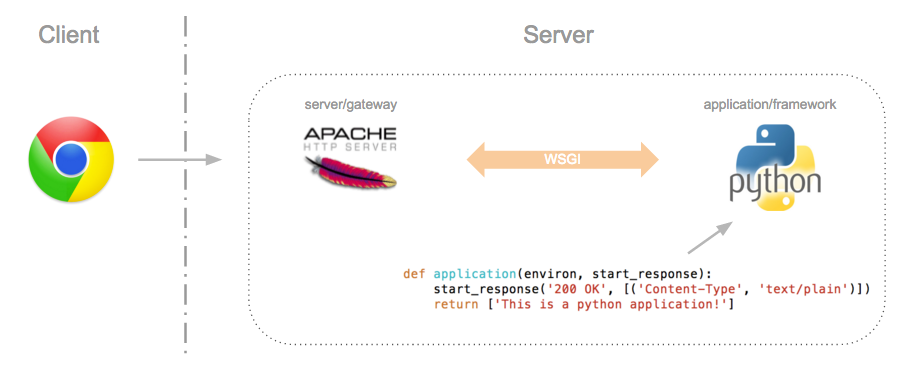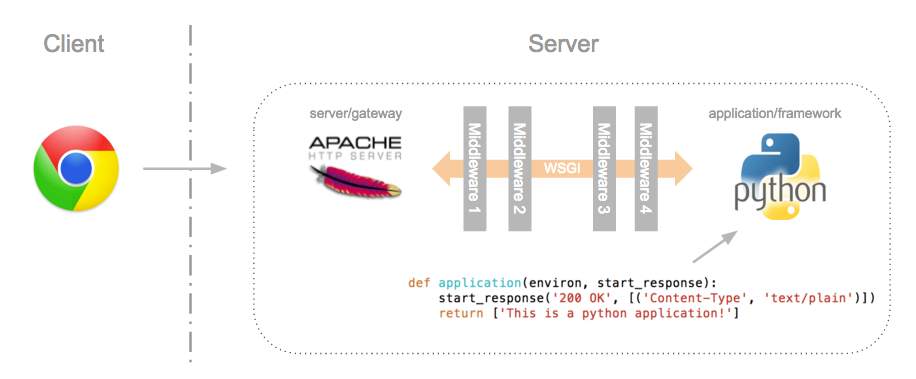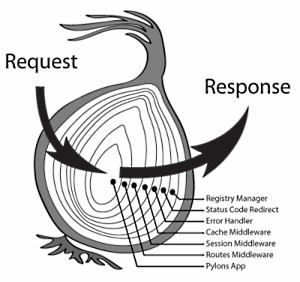理解 WSGI 框架
This document specifies a proposed standard interface between web servers and Python web applications or frameworks, to promote web application portability across a variety of web servers. -—–PEP 0333
 图片源自 A Primer On WSGI
图片源自 A Primer On WSGI
An Introduction to WSGI
在 java web 领域,支持 servlet API 的 java application 都可运行在支持 servlet API 的 web server (http server) 上。随着 web 不断发展,python application/framework 也如雨后春笋般涌出,如:zope, webware, skunkweb 等等。但是它们的接口存在差异,导致难以跨 web server 运行,所以 python 社区定义了一种如 servlet API 般标准通用的接口------WSGI。
PEP 0333 – Python Web Server Gateway Interface 是一种 web server or gateway 和 python web application or framework 之间简单通用的接口,符合这种接口的 application 可运行在所有符合该接口的 server 上。通俗的讲,WSGI 规范了一种简单的接口,解耦了 server 和 application,使得双边的开发者更加专注自身特性的开发。
- Web server/gateway: 即 HTTP Server,处理 HTTP 协议,接受用户 HTTP 请求和提供并发,调用 web application 处理业务逻辑。通常采用 C/C++ 编写,代表:apache, nginx 和 IIS。
- Python Web application/framework: 专注业务逻辑的 python 应用或者框架。

The Application/Framework Side
Application/framework 端必须定义一个 callable object,callable object 可以是以下三者之一:
- function, method
- class
- instance with a __call__ method
Callable object 必须满足以下两个条件:
- 接受两个参数:字典(environ),回调函数(start_response,返回 HTTP status,headers 给 web server)
- 返回一个可迭代的值
基于 callable function 的 application/framework 样例如下:
def application(environ, start_response):
start_response('200 OK', [('Content-Type', 'text/plain')])
return ['This is a python application!']
基于 callable class 的 application/framework 样例如下:
class ApplicationClass(object):
def __init__(self, environ, start_response):
self.environ = environ
self.start_response = start_response
def __iter__(self):
self.start_response('200 OK', [('Content-type', 'text/plain')])
yield "Hello world!\n"
The Server/Gateway Side
Server/gateway 端主要专注 HTTP 层面的业务,重点是接收 HTTP 请求和提供并发。每当收到 HTTP 请求,server/gateway 必须调用 callable object:
- 接收 HTTP 请求,但是不关心 HTTP url, HTTP method 等
- 为 environ 提供必要的参数,实现一个回调函数 start_response,并传给 callable object
- 调用 callable object
我们直接使用支持 WSGI 框架的 wsgiref 库,编写一个样例:
# application/framework side
def application(environ, start_response):
start_response('200 OK', [('Content-Type', 'text/plain')])
return ['This is a python application!']
# server/gateway side
if __name__ == '__main__':
from wsgiref.simple_server import make_server
server = make_server('0.0.0.0', 8080, application)
server.serve_forever()
运行后,对于任意的 url 和 method,本例的返回值均为 ‘This is a python application!’:
$curl 127.0.0.1:8080
This is a python application!
$ curl 127.0.0.1:8080/test
This is a python application!
Middleware: Components that Play Both Sides
Unix philosophy: do one thing and do it well.

Middleware 处于 server/gateway 和 application/framework 之间,对 server/gateway 来说,它相当于 application/framework;对 application/framework 来说,它相当于 server/gateway。每个 middleware 实现不同的功能,我们通常根据需求选择相应的 middleware 并组合起来,实现所需的功能。比如,可在 middleware 中实现以下功能:
- 根据 url 把用户请求调度到不同的 application 中。
- 负载均衡,转发用户请求
- 预处理 XSL 等相关数据
- 限制请求速率,设置白名单

WSGI 的 middleware 体现了 unix 的哲学之一:do one thing and do it well。事实上,在定义 WSGI 框架的时候,设计者就要求 server/gateway 和 application/framework 双方尽可能的简单,同时也要求 middleware 设计的简单而专一,PEP 333 提到:
If middleware can be both simple and robust, and WSGI is widely available in servers and frameworks, it allows for the possibility of an entirely new kind of Python web application framework: one consisting of loosely-coupled WSGI middleware components.
本例实现了一个 IPBlacklist 的 middleware:
class IPBlacklistMiddleware(object):
def __init__(self, app):
self.app = app
def __call__(self, environ, start_response):
ip_addr = environ.get('HTTP_HOST').split(':')[0]
if ip_addr not in ('127.0.0.1'):
return forbidden(start_response)
return self.app(environ, start_response)
def forbidden(start_response):
start_response('403 Forbidden', [('Content-Type', 'text/plain')])
return ['Forbidden']
def application(environ, start_response):
start_response('200 OK', [('Content-Type', 'text/plain')])
return ['This is a python application!']
if __name__ == '__main__':
from wsgiref.simple_server import make_server
application = IPBlacklistMiddleware(application)
server = make_server('0.0.0.0', 8080, application)
server.serve_forever()
测试如下:
# 从本机测试
$ curl 127.0.0.1:8080/test
This is a python application!
# 从其它主机测测试
$ curl 10.10.10.2:8080/test
Forbidden
Path Dispatching
至此样例的一个不足之处是对于任意的 url 和 method,程序的返回值均为 ‘This is a python application!’,所以我们需要增加 path dispatch 功能。由于 WSGI 框架下的 server/gateway 不处理 url 和 method,所以 url mapping 需由 application/framework 端完成。注意到参数 environ,它包含以下变量:
- REQUEST_METHOD: 即 HTTP method
- PATH_INFO: 即 HTTP url
所以 application/framework 可以根据 environ 的 REQUEST_METHOD 和 PATH_INFO 实现 path dispatch,样例如下:
class IPBlacklistMiddleware(object):
def __init__(self, app):
self.app = app
def __call__(self, environ, start_response):
ip_addr = environ.get('HTTP_HOST').split(':')[0]
if ip_addr not in ('127.0.0.1'):
return forbidden(start_response)
return self.app(environ, start_response)
def dog(start_response):
start_response('200 OK', [('Content-Type', 'text/plain')])
return ['This is dog!']
def cat(start_response):
start_response('200 OK', [('Content-Type', 'text/plain')])
return ['This is cat!']
def not_found(start_response):
start_response('404 NOT FOUND', [('Content-Type', 'text/plain')])
return ['Not Found']
def forbidden(start_response):
start_response('403 Forbidden', [('Content-Type', 'text/plain')])
return ['Forbidden']
def application(environ, start_response):
path = environ.get('PATH_INFO', '').lstrip('/')
mapping = {'dog': dog, 'cat': cat}
call_back = mapping[path] if path in mapping else not_found
return call_back(start_response)
if __name__ == '__main__':
from wsgiref.simple_server import make_server
application = IPBlacklistMiddleware(application)
server = make_server('0.0.0.0', 8080, application)
server.serve_forever()
测试如下:
$ curl 127.0.0.1:8080/dog
This is dog!
$ curl 127.0.0.1:8080/cat
This is cat!
$ curl 127.0.0.1:8080/monkey
Not Found